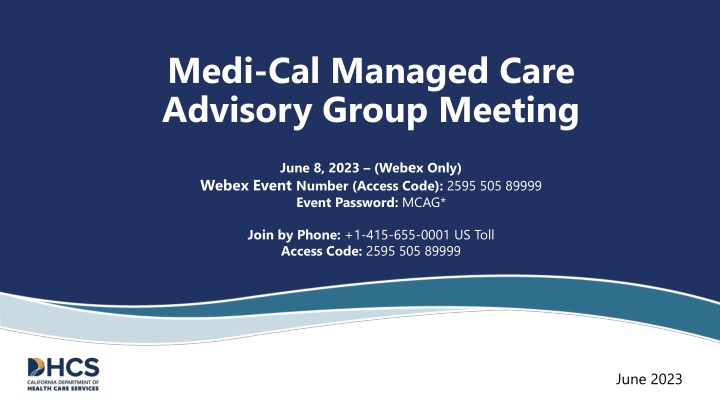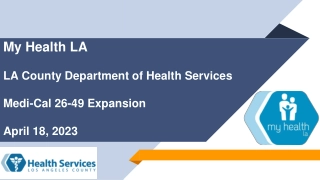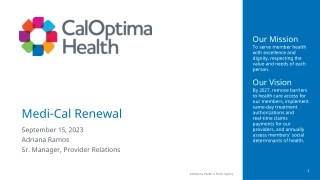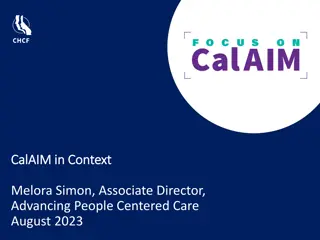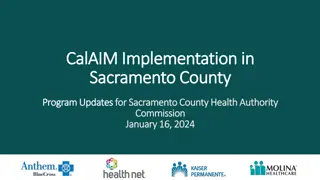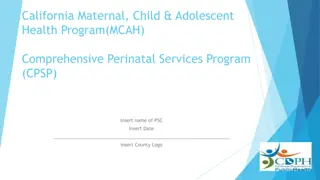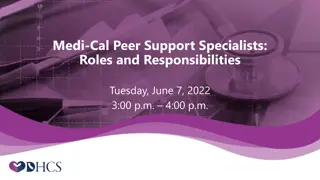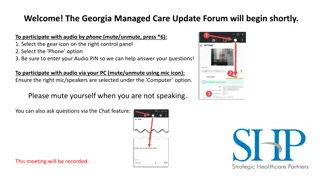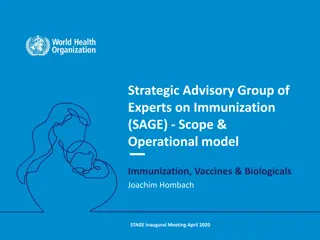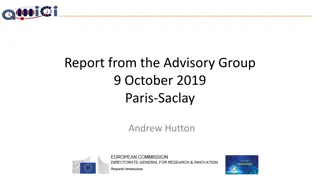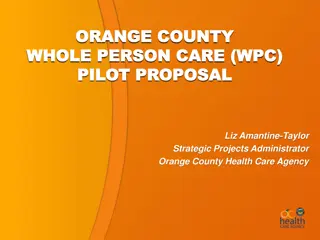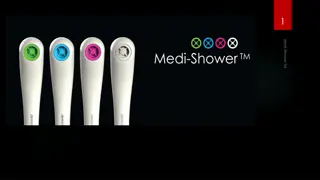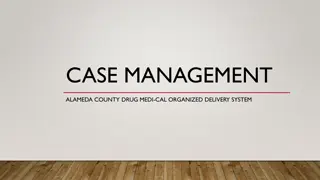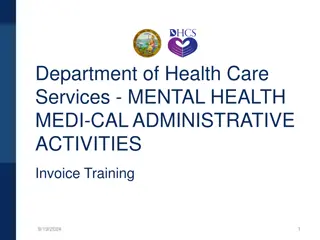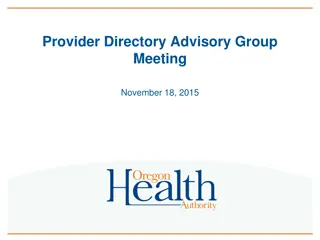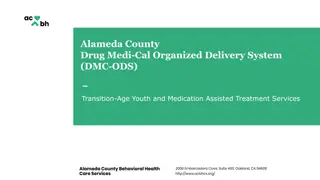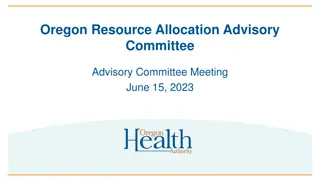Medi-Cal Managed Care Advisory Group Meeting - June 8, 2023
The Medi-Cal Managed Care Advisory Group Meeting scheduled for June 8, 2023, will focus on various topics including renewals/redeterminations, 2024 transition policy guide, transportation benefits, community health workers, and more. The meeting will feature key speakers providing insights and updates on Medi-Cal managed care operations and upcoming changes. Attendees are encouraged to join online using the provided Webex details to participate in interactive discussions and ask questions to the panelists.
Download Presentation

Please find below an Image/Link to download the presentation.
The content on the website is provided AS IS for your information and personal use only. It may not be sold, licensed, or shared on other websites without obtaining consent from the author.If you encounter any issues during the download, it is possible that the publisher has removed the file from their server.
You are allowed to download the files provided on this website for personal or commercial use, subject to the condition that they are used lawfully. All files are the property of their respective owners.
The content on the website is provided AS IS for your information and personal use only. It may not be sold, licensed, or shared on other websites without obtaining consent from the author.
E N D
Presentation Transcript
Medi-Cal Managed Care Advisory Group Meeting June 8, 2023 (Webex Only) Webex Event Number (Access Code): 2595 505 89999 Event Password: MCAG* Join by Phone: +1-415-655-0001 US Toll Access Code: 2595 505 89999 June 2023
Thank you for joining! Please place all calls on mute, not hold, to avoid hold music. To ask the cohost(s)/panelist(s) a question through chat, use the Q&A option in WebEx. Once each presenter is done, we ask that you utilize the raise your hand function to ask questions. Presentation operator (lead analyst) will read off questions posed in Question and Answer section of the webinar software. Please note: to send a question or comment during the session, send to all cohosts.
Agenda Welcome and Introductions Renewals/Redeterminations 2024 Transition Policy Guide Memorandum of Understanding Transportation Benefit Community Health Worker (CHW) Population Health Management (PHM) Enhanced Care Management: Children/Youth POF Open Discussion
Welcome and Introductions Dana Durham Division Chief, Managed Care Quality and Monitoring Division
Renewals/Redeterminations Yingjia Huang Assistant Deputy Director, Health Care Benefits and Eligibility
2024 Transition Policy Guide Michelle Retke Division Chief, Managed Care Operations Division
Commercial MCP Contracts, Effective Jan. 1, 2024 Managed Care Plans Counties Blue Cross of California Partnership Plan ("Anthem") Alpine, Amador, Calaveras, El Dorado, Fresno, Inyo, Kern, Kings, Madera, Mono, Sacramento, San Francisco, Santa Clara, Tuolumne Blue Shield of California Promise Health Plan San Diego CHG Foundation d.b.a. Community Health Group Partnership Plan San Diego Health Net Community Solutions, Inc. Amador, Calaveras, Inyo, Los Angeles (with subcontract to Molina for 50% of membership), Mono, Sacramento, San Joaquin, Stanislaus, Tulare, Tuolumne Molina Healthcare of California Riverside, Sacramento, San Bernardino, San Diego, (and in Los Angeles subcontractor to Health Net for 50% of membership)
MCP Model Change 17 counties intend to change Medi-Cal Managed Care models Conditionally Approved 2024 Models:* Current Models: (n=1) (n=1) Regional Model (n=5) (n=18) COHS and Single Plan Model (n=37) (n=8) (n=14) Two Plan Model (n=14) (n=2) (n=14) o GMC Model (n=2) * Pending plan readiness and federal authorization
2024 MCP Transition Policy Guide: Expectations specific to the 2024 Transition Target Audience Purpose Policy Content The Policy Guide will contain guidance related to the January 1, 2024, transition of Medi-Cal Managed Care Plans. It is envisioned that the Policy Guide would contain requirements related to the following transition topics: Member enrollment Continuity of care Data transfer Payment and program transitions Post-Transition Monitoring and Related Reporting Requirements Other topics pertinent to the transition, such as Incentive Program participation/ obligations after January 1, 2024 MCP staff impacted by the January 1, 2024, transition, either as an exiting MCP or a new MCP will be the primary user of this Policy Guide. The Policy Guide will function as a requirements documentfor MCPs transition activity, incorporating links to existing, applicable All Plan Letters (APLs), as well as new MCP requirements. The Policy Guide will also offer an organized, reference source for DHCS staff charged with monitoring and oversight of the transition. The Policy Guide will afford DHCS a nimble approach to respond to feasibility challenges and issues impacting members, providers, and MCPs. Out of scope: Internal DHCS policies, Operational Readiness. DHCS released the Policy Guide in May and expects approximately quarterly updates thereafter.
Policy Guide Outline DHCS anticipates including the below topics in the forthcoming Policy Guide. Table of Contents Updates from Prior Version Introduction Context Purpose, Scope, Audience Key Definitions Member Enrollment Noticing Enrollment policies for new Medi- Cal members during transition period Enrollment policies for members transitioning from exiting plans Other Kaiser-related enrollment policies Other enrollment policies Data Transfer: From exiting plan to DHCS From DHCS to receiving plans Plan-to-plan Payment and Program transitions IPP intersection HHIP PATH Acute care payment responsibility Network development incentives / considerations PHM HRA timing Post-Transition Monitoring and Related Reporting Requirements Appendix General definitions Continuity of Care Context Special populations Continuity of Care for Providers Continuity of Care for Covered Services Continuity of Care Coordination and Management Information Additional Continuity of Care Protections for All Members of Exiting MCPs Transition Policy for Enhanced Care Management (tentative for Q2 release) Transition Policy for Community Supports (tentative for Q2 release) The Q2 release will indicate anticipated timeline for subsequent releases for these items Items within these sections will be ready for release in Q2 10
Memorandum of Understanding Amara Bahramiaref Branch Chief, Policy, Utilization & External Relations Branch
Objectives for Todays Discussion Overview of Memorandums of Understanding (MOUs) and timelines Review MOUs for 2024 go-live Review MOUs for 2025 go-live 12
MOU Requirements The 2024 Medi-Cal Managed Care Contract (Contract) Exhibit A, Attachment III, Section 5.6. requires Managed Care Plans (MCPs) to execute MOUs with a range of entities, agencies, and programs (e.g., counties, local health departments, Regional Centers) (other party). The Contract sets forth minimum requirements for what must be included in every MOU executed by the MCP and other party. The MOU templates that DHCS will release will include the minimum requirements and optional terms that the MCP and other party may choose to include. Once the MOU templates are developed, DHCS will share them with MCPs and entity stakeholders for review and feedback.
Base MOU Template Requirements Every MOU template contains the following provisions as required under the Contract. Services Covered by This MOU: Describes the services that MCP and the other party must coordinate for Members. Disaster Emergency Preparedness: Requires parties to have policies and procedures to ensure the continued care coordination for services in the event of a disaster or emergency. Party Obligations: Describes each party's provision of services and oversight responsibilities (e.g., each party must designate a day-to- day liaison to coordinate with the other party). Quality Improvement: Describes the MCP's annual reporting on quality of the care coordination, referral processes, and collaboration between the parties, including that the annual report must be submitted to DHCS and made public. Training and Education: Requires MCP to provide education to Members about services available and train Network Providers, Subcontractors and Downstream Subcontractors on the MOU requirements and services provided by the other party. Document Retention: Requires MCP to retain all documents related to the MOU requirements for at least ten years. Collaboration: Describes the collaboration required by the parties to ensure MOU requirements are met, such as meeting quarterly to address barriers to coordination and conducting quality improvement activities. Data Sharing and Confidentiality: Describes the minimum data and information that MCP must share with the other party to ensure the MOU requirements are met and describes the data and information the other party may share with MCP to improve care coordination and referral processes. Referrals: Describes the process to make referrals by one party to the other as appropriate. This section also addresses Closed Loop Referrals policies and procedures required as of January 1, 2025. Dispute Resolution: Describes the policies and procedures for resolving disputes between the parties and the process for bringing the disputes to DHCS (and other departments as appropriate) when the parties are unable to resolve disputes. Care Coordination: Describes the policies and procedures for coordinating care between the parties, addressing barriers to care coordination, and ensuring ongoing monitoring and improvement of care coordination. General: Sets forth additional general contract requirements, such as that the MCP must publicly post the MOU and how notice will be provided. 14
Timeline for MOUs DHCS plans to release an APL attaching MOU base and bespoke MOU templates this month. DHCS aims to engage stakeholders for input on draft MOU templates starting in summer 2023 DHCS will hold an open comment period to obtain written feedback on draft MOUs and will hold a series of webinars for interested stakeholders
Status of MOU Development 2024 Go Live Eight MOU templates will be released in advance of January 1, 2024. Agency/Entity Type Program(s) LGA/County Behavioral Health Departments LGA/County Behavioral Health Departments Specialty Mental Health Services Substance Use Disorder Services Including, without limitation, California Children s Services (CCS), Maternal, Child and Adolescent Health (MCAH), TB Direct Observed Therapy Local Health Departments Local Health Departments Women, Infant, & Children (WIC) Regional Centers LGA Not Applicable In-Home Services and Supports (IHSS) LGA/County Social Services Department County Social Services programs and Child Welfare LGA Targeted Case Management 16
MOU Development 2025 Go Live Eight MOU templates will be released in advance of January 1, 2025. Agency/Entity Type HCBS Waiver Agencies and Programs LGA/Jails, Juvenile Facilities and Probation Departments Continuum of Care First 5 Programs Area Agencies on Aging California Caregiver Resource Centers Local Education Agencies (LEAs) Indian Health Services/Tribal Entities 17
Transportation Benefit: . Non-Medical and Non-Emergency Medical Transportation Services Laura Briones Health Program Specialist II, Managed Care Quality and Monitoring Division
What is Non-Emergency Medical Transportation? NEMT is for members with a medical and physical condition who cannot be transported by ordinary means of public or private conveyance such as by Uber/Lyft, taxi, bus, private vehicle, etc. The member must have a signed Physician Certification Statement (PCS) form authorizing NEMT by their provider in order to request an NEMT ride. 22 CCR Section 51323 outlines the four NEMT modalities: Ambulance services Litter van services Wheelchair van transport By Air
Transportation Providers vs. Brokers Transportation brokers have their own network of NEMT and/or NMT providers to provide rides to members. Brokers conduct administrative activities on behalf of the MCP such as maintaining a call center for the members to request NEMT or NMT rides, scheduling, and arranging rides for members. Transportation providers provide the ride and are required to meet the Medi-Cal enrollment requirements in order to provide the service. MCPs are required to ensure transportation brokers and providers comply with all contractual requirements, including timely access, grievances and appeals, enrollment of NEMT or NMT providers as Medi-Cal providers, and utilization management.
Policies Addressing Missed/Delayed Rides The transportation APL 22-008 was updated in August 2022 to include specific policies to mitigate the issues surrounding missed/delayed rides. Added the requirement for a transportation liaison role within the MCP to address urgent time sensitive issues when a broker/provider cannot provide a resolution for the member/provider. Specified in the APL that MCPs must monitor late arrival and no-show rates and ensure that NEMT and/or NMT providers arrive with 15 minutes of their scheduled appointments times. Added tracking and monitoring requirements to identify specific drivers based on service date, time, pick- up/drop-off location, and member name. Added the requirement for MCPs to impose corrective action on transportation brokers and network providers if non-compliance is identified.
Transportation for members in SNFs Problem/Issue: Members residing in Skilled Nursing Facilities are experiencing transportation access issues to critical appointments such as Dialysis. DHCS has directed MCPs to 1) identify all member residing in SNFs who are in need of dialysis 2) Ensure the members are receiving consistent and timely transportation services and have standing orders for recurring appointments so dialysis appointments are not delayed or missed 3) Ensure recurring transportation needs for SNF members are identified and arranged for. DHCS is working closely with the MCPs and conducting ongoing monitoring of the transportation benefit to ensure MCPs are compliant with APL 22-008.
Community Health Worker (CHW) Frances Harville Chief, Policy and Housing Programs Section
Background The Department of Health Care Services (DHCS) added Community Health Worker (CHW) services as a Medi-Cal benefit starting July 1, 2022. Community Health Worker (CHW) services are preventive health services to prevent disease, disability, and other health conditions or their progression; to prolong life; and promote physical and mental health. CHW services are considered Medically Necessary for beneficiaries: With one or more chronic health conditions (including behavioral health), Exposure to violence and trauma, Who are at risk for a chronic health condition or environmental health exposure, Who face barriers meeting their health or health-related social needs, and/or who would benefit from preventive services, Results of a social drivers of health screening indicating unmet health-related social needs, such as housing or food insecurity or exposure to Adverse Childhood Event. See DHCS CHW Manual for full list of Eligibility Criteria.
Covered CHW Services Health education Health navigation Screening and assessment Individual support or advocacy Violence Prevention Services
Member Eligibility Criteria for CHW Services CHW services require a written recommendation submitted to the MCP by a physician or other licensed practitioner of the healing arts within their scope of practice under state law. CHW services are considered medically necessary for Members with one or more chronic health conditions: Including Behavioral Health or exposure to violence and trauma, Those who are at risk for a chronic health condition or environmental health exposure, who face barriers in meeting their health or health-related social needs, And/or who would benefit from preventive services.
CHW Provider Requirements and Qualifications CHWs must have lived experience that aligns with and provides a connection between the CHW and the Member or population being served. CHWs may include individuals known by a variety of job titles, including: Promoters, Community Health Representatives, Navigators, Other non-licensed public health workers, including violence prevention professionals, with the qualifications specified in the next slide.
CHW Provider Requirements and Qualifications Work Experience Pathway: Certificate Pathway: At least 2000 hours working as a CHW in paid or volunteer positions within the previous three years. CHW Certificate: A valid certificate of completion of a curriculum that attests to demonstrated skills and/or practical training relating to a CHW. May provide CHW services without a certificate of completion for a maximum period of 18 months. Violence Prevention Professional Certificate: For individuals providing CHW violence prevention services only. A CHW must earn a certificate of completion within 18 months of the first CHW visit provided to a member.
Supervising Provider Ensures that CHWs meet the qualifications, oversees CHWs and the services delivered, and submits claims for services provided by CHWs. Supervising Providers must maintain evidence of this experience. Qualified Supervising Providers are enrolled Medi-Cal providers and include: Individual licensed Providers Hospitals Outpatient clinic Local Health Jurisdiction (LHJ) Community-Based Organization (CBO)
Plan of Care For members who need multiple ongoing CHW services or continued CHW services after 12 units of services as defined in the Medi-Cal Provider Manual. Written document developed by one or more licensed providers describing CHW- provided supports and to address ongoing needs for a beneficiary. The Provider ordering the plan of care does not need to be the same Provider who initially recommended CHW services or the Supervising Provider for CHW services. Plan of care may not exceed a period of one year. CHWs may participate in the development of the plan of care and may take a lead role in drafting the plan of care if done in collaboration with the Member s care team and/or other Providers referenced in this section.
CHW Contracting As part of their Network composition, MCPs must ensure and monitor sufficient Provider Networks within their service areas, including for CHW services. DHCS strongly encourages MCPs to contract with organizations that include CHWs including: Local public health departments CBOs including those working with specific populations of focus through ECM or Community Support providers (to the extent there is no duplication of services/payment) Community based Providers with imbedded CHWs
Resources DHCS recommends MCPs review and utilize the resources provided by the California Health Care Foundation.
Summary of Population Health Management (PHM) Readiness Deliverable Submissions DHCS Review Findings, Question 20 December 2022
Intersection with Enhanced Care Management (ECM) and Community Supports (CS) (b) Contracting with organizations with CHWs on staff to serve as ECM and/or CS Providers. Ensuring non-duplication between payment for ECM/Community Supports and the new CHW benefit. Responses: All attested they contract with CS Providers who have CHW staff serving members, all but one attested the same for their ECM Provider network. Provide out to CHW Providers. Provide education to Providers on guidelines for CHW s scope of benefits and non-duplication services. Majority of non-duplication strategy: claims utilization review. Innovative approaches to avoid non-duplication: automation in utilization software, Member intake screening protocol, routine executive CHW utilization review.
Building Provider Networks for the CHW Benefit (c) Whether the MCP has any CHWs on staff and what tasks they perform. MCP s strategies for recruiting and growing the CHW provider network. MCP s referral pathways to CHW services, including how the MCP ensures Closed Loop Referrals. Responses: CHWs are identifying, locating and navigating community and medical services, accompanying members to medical appointments, and assisting in completing forms and applications to access services. MCPs providing outreach and support to educate members about covered services, need for preventive care, self-management, and access to other services such as Community Supports, ECM and other community resources. Close the loop by tracking the progress of the referral, conducting follow-up calls to the member to verify member received the help they needed and provide additional connections to community resources.
CHW Benefit Outreach & Education on CHW Scope of Practice, Benefit, and Services Availability for Providers and Members (d)+(e) Member communication strategy and tools in culturally and linguistically appropriate manner to inform members how to utilize CHW services. Provider training on CHW scope of practice, care team integration , and Member referral processes for CHW services. Responses: Providing information via Member s handbook, Member s websites. Disseminate marketing information in communities, settings, and situations where our members live and seek services. Identify members who may benefit from these services and identify how to direct members to these services. Develop provider training inclusive of the CHW scope of practice, integration, and referral process.
Bright Spots: Workforce Development MCPs attested they are already working with, or plan to work with, State/local agencies, colleges and CBOs to provide CHW training. MCPs stated they already directly hire or contract with CHWs or intend to train CHW-like staff to attain CHW certification.
Bright Spots: Access to Care Facilitation Some MCPs are indicating leveraging place-based data to focus efforts in underserved and communities: Healthy Places Index, Heat Maps , zip codes, stratifications informed by CQS Bold Goals. Various MCPs indicate current or future PHM strategy includes embedding CHWs into acute and primary care settings, street teams, and other community catchment areas to support referral linkage. Many MCPs indicate current or planned use of FindHelp.org, 211, or similar external resource registry to promote CHW integration and/or referrals.
Looking Ahead CHW Provider Networks MCP Support
References All Plan Letter (APL) 22-016 Readiness Deliverable
Overview of CalAIM Population Health Management (PHM), Enhanced Care Management (ECM), and Preventive Services Report Quality and Population Health Management
Agenda 15 min Population Health Management (PHM) PHM Monitoring Transitional Care Services Population Needs Assessment PHM Service and Risk Stratification, Segmentation and Tiering Enhanced Care Management (ECM) ECM Overview Children and Youth Population of Focus Q&A 15 min Preventive Services Report 15 min
PHM Program Overview DHCS has established a cohesive, statewide approach to Population Health Management (PHM) through which managed care plans (MCPs) and their networks and partners are responsive to individual member needs within the communities they serve. PHM also sets forth a common framework and set of expectations for MCPs. Managed care plans must have a whole person-centered PHM program that identifies and addresses members preventive, physical, behavioral health, and social needs. Several of the key elements of PHM were already in place in the Medi-Cal program through both Department of Health Care Services (DHCS) policies and MCPs own programs. PHM is a journey rather than a destination. Over time, the program will evolve to support more integration across delivery systems, moving beyond the current MCP requirements.
PHM Program Framework Today: Progress Update on Risk Stratification and Segmentation Working Group Today: Enhanced Care Management Today: Update on Population Needs Assessment Redesign Next: Population Health Management Program Evaluation Population Health Management Strategy and Roadmap (ca.gov)
PHM Program Monitoring Approach for MCPs The purpose of DHCS s PHM Program monitoring approach is to assess the implementation and effectiveness of each MCP's PHM Program. MCPs should be responsive to individual member needs within the communities they serve inclusive of preventive, physical, behavioral health, and social needs. Through these metrics, DHCS will be able to track: Existing Reporting (ECM, IPP) PHM Program implementation, operations and effectiveness measured at the plan level; New Key Performance Indicators Quality Measures Gaps for additional DHCS guidance or clarifications; Monitoring Approach PHM Program impact on outcomes over time; and Priority issue areas that require DHCS follow-up with MCPs. CalAIM: Population Health Management (PHM) Policy Guide ECM = Enhanced Care Management, IPP = Incentive Payment Program 49
PHM Program Monitoring Approach for MCPs DHCS s goal for the PHM monitoring process is to gain a holistic perspective on PHM Program implementation at each MCP. The monitoring approach will be organized into domains. Domains Categories Quarterly submission by MCPs for Plan-focused performance. Stratified by age, race, ethnicity, language. Launching soon! First submission 8/15/23 Initial focus: Understanding landscape DHCS discussions with outliers in performance. Basic Population Health Management (BPHM) Prevention Services Primary Care Engagement/ Appropriate Utilization Chronic Disease Management CHW Integration Risk Stratification Segmentation and Tiering (RSST) Complex Care Management (CCM) Enhanced Care Management (ECM) Transitional Care Services (TCS) Children and Youth Birthing Populations Individuals with Behavioral Health Needs Equity (include all stratified measures) PHM Program Areas/Themes Populations Cross Cutting CalAIM: Population Health Management (PHM) Policy Guide, starting pg. 33 New Key Performance Measure
